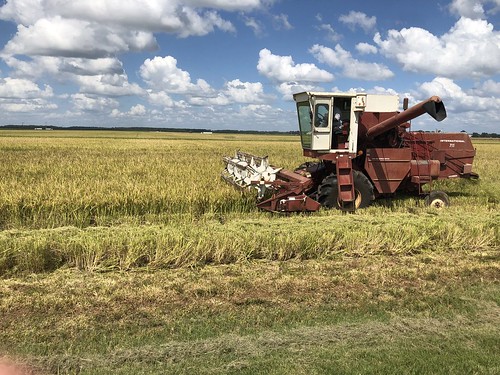Arkansas rice production bounced back in 2018
By Ryan McGeeney
U of A System Division of Agriculture
April 8, 2019
Fast Facts:
- Average rice yield rises slightly
- With more than 1.4 million acres harvested in 2018, production was highest in several years
- Prevented planting in 2019 will likely impact overall rice numbers this year
(377 words)
(Download this story in MS Word format here.)
LITTLE ROCK — After a bruising 2017, in which substantial spring flooding cost growers in the state an estimated $175 million in lost production and damaged acreage, rice growers saw higher production in 2018 than in any of the three previous years, according to an April 4 report from the U.S. Department of Agriculture.
In the report, produced by the USDA’s National Agricultural Statistics Service, rice growers saw clear improvements in harvested acres, yield and production throughout the state. Most of the largest increases in yield, percentagewise, were seen in eastern Arkansas counties that suffered flooding losses most acutely in 2017.
Phillips County, which suffered between $400,000 and $1 million in crop loss in 2017, saw its rice production more than double from 1 million hundredweight to about 2.13 million hundredweight. Increases of similar proportions were reported in Lawrence, St. Francis, Ashley and Desha counties.
While the county-by-county acreage estimates provided in the NASS report often differ from those estimates provided by the Farm Service Agency, also part of the USDA, the statewide numbers are typically very similar.
Jarrod Hardke, extension rice agronomist for the University of Arkansas System Division of Agriculture, said that while the higher production numbers were a welcome sight, the higher rice acreage in 2018 wasn’t necessarily a surprise, as it followed the natural cycle of shifting acreage, crop rotation and prospective planting in response to relative commodity prices.
Looking forward, Hardke said that with the window for much of the state’s planned early planted rice closing for 2019, shifts in acreage are an open question.
“Until a week ago, I’d maintained my expectation that we’ll remain close to flat, at 1.4 million acres of rice,” Hardke said. “But we’ve seen what’s happened with this spring. After a week of dry weather, we saw rains again over the weekend, with more pointed our way.
“1.4 million acres is still the target, but if this pattern doesn’t give, we’ll possibly head down toward 1.2 million acres,” he said. “At this point, we’re staring at a downward trend, but we have a while to go yet before we start losing rice acres.”
To learn about row crop agriculture in Arkansas, contact your local Cooperative Extension Service agent or visit www.uaex.uada.edu. Follow us on Twitter at @AR_Extension.
About the Division of Agriculture
The University of Arkansas System Division of Agriculture’s mission is to strengthen agriculture, communities, and families by connecting trusted research to the adoption of best practices. Through the Agricultural Experiment Station and the Cooperative Extension Service, the Division of Agriculture conducts research and extension work within the nation’s historic land grant education system.
The Division of Agriculture is one of 20 entities within the University of Arkansas System. It has offices in all 75 counties in Arkansas and faculty on five system campuses.
Pursuant to 7 CFR § 15.3, the University of Arkansas System Division of Agriculture offers all its Extension and Research programs and services (including employment) without regard to race, color, sex, national origin, religion, age, disability, marital or veteran status, genetic information, sexual preference, pregnancy or any other legally protected status, and is an equal opportunity institution.
# # #
Media Contact: Ryan McGeeney
Communication Services
U of A System Division of Agriculture
Cooperative Extension Service
(501) 671-2120
rmcgeeney@uada.edu
